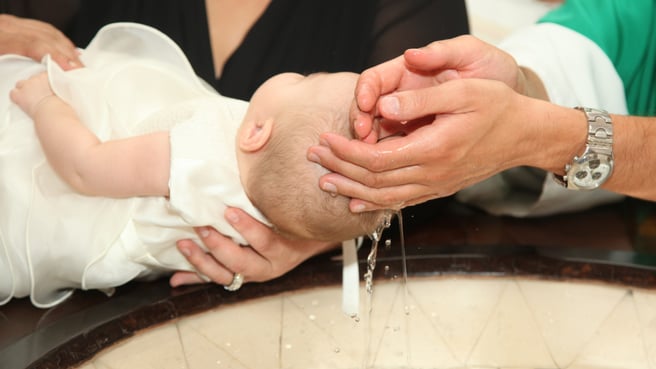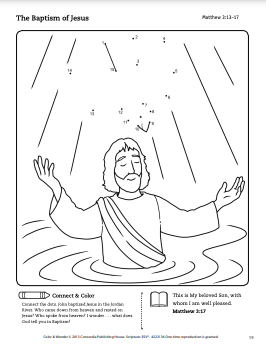Returning to our confirmation days, we know that baptism is not a mere symbol or expression of devout faith in God. In fact, baptism is entirely God’s act. In this blessed Sacrament, God brings life and salvation, specifically, the Holy Spirit who creates saving faith in Christ, forgiveness of sins and everlasting life. God makes us His child, placing His everlasting mark of ownership on a wretched, yet redeemed sinner.
Jesus says in Matthew 28:19-20 “Go therefore and make disciples of all nations, baptizing them in the name of the Father and of the Son and of the Holy Spirit, teaching them to observe all that I have commanded you. And behold, I am with you always, to the end of the age.” Acts 2:38: “Repent and be baptized every one of you in the name of Jesus Christ for the forgiveness of your sins, and you will receive the gift of the Holy Spirit.”
Children may ask (as do adults): Do I have to be baptized to go to heaven? The simple answer is no. However, such a question requires more attention: what’s behind this inquiry? God tells us to baptize and we need what baptism provides. Secondly, let’s remember that baptism is a gift. To ask about the necessity of baptism is like asking if I have to receive a present from a friend or loved one. Thanks for the new bike, Dad. By the way, are you still my Dad if I refuse the bike? Accepting a gift is a reaction of love and respect. You just receive it gratefully.
God's Word Connected to Plain Water
In God’s infinite wisdom, He chose to connect the blessings of the means of grace to visible elements. Baptism is no exception. God’s Word is connected to plain water. This relationship affords us a number of natural methods to teach baptism.
Martin Luther encourages Christians to remember their baptism every time they wash. Help students to understand by relating sin to dirt and germs. Water washing away what could make us sick. Similarly, baptism, washes away the illness of sin.
If students are curious about infant baptism, relate the Sacrament to vaccinations. Babies receive vaccinations because they need them. To a great extent, vaccinations are a matter of life and death. Similarly, infants need what baptism brings. Second, vaccinations are required by law and necessary for living among others. Similarly, sinners cannot be in the presence of God without the vaccination of baptism.
Depending on the age and maturity of your students, you can also explain that the healthful benefits of vaccinations do not require the baby’s understanding. The polio vaccine is effectual even though the baby understands nothing but the pain of the needle.

Regarding practical methods, there is no substitute for taking students into the sanctuary and up to the baptismal font. If any of your students were baptized at your church, point this out. For all students, seeing the baptismal font in God’s house can help them to internalize God as the “doer” or “actor” in baptism. The parents hold the baby. The pastor pours the water, but God does all the work.
Christ is the Light of the World
Point to the Christ candle and explain that it is lit to remind us that Christ is the light of the world, that He is not only present for the baptism, but also comes to live within us in His Holy Spirit. John 8:12 reads, “Again Jesus spoke to them, saying, "I am the light of the world. Whoever follows me will not walk in darkness, but will have the light of life.” Draw attention to the white cloth used to dry the head or baptismal gown that envelops the baby’s body. Connect the brilliant white of the material to the purity of Christ and the total forgiveness we have in baptism. Consider these to verses to present with the lesson. Matthew 28:3 reads: “His appearance was like lightning, and his clothing white as snow.” Isaiah 1:18: “Come now, let us reason together, says the Lord: though your sins are like scarlet, they shall be as white as snow; though they are red like crimson, they shall become like wool."
Ideas for Teaching about Baptism
Consider these activities to support your lessons on baptism. Attach a long sheet of wide ream paper to the wall. Invite each student to draw himself on the paper. Once the pictures are on the paper, have the students draw a giant waterfall splashing down on them. Then add a cross at the top of the waterfall. Explain the imagery of the cross and water, the blessings of forgiveness in Christ that come in baptism.
This activity would work best during the summer or perhaps at a church picnic. Using non-permanent marker or washable body paint, invite students to write or draw sins on their arms and legs. Use a hose to wash the “sins” away. Make sure the children understand that the water is a reminder of what God did at their baptism. With older students, try the same activity with water balloons.
There are so many good ways to present baptism to children. We do well when we teach regarding this blessed Sacrament regularly, stressing God as the One working, and that baptism is His gift to us.
Order a copy of Lutheranism 101: Baptism to enhance students' education about this important Sacrament.
















